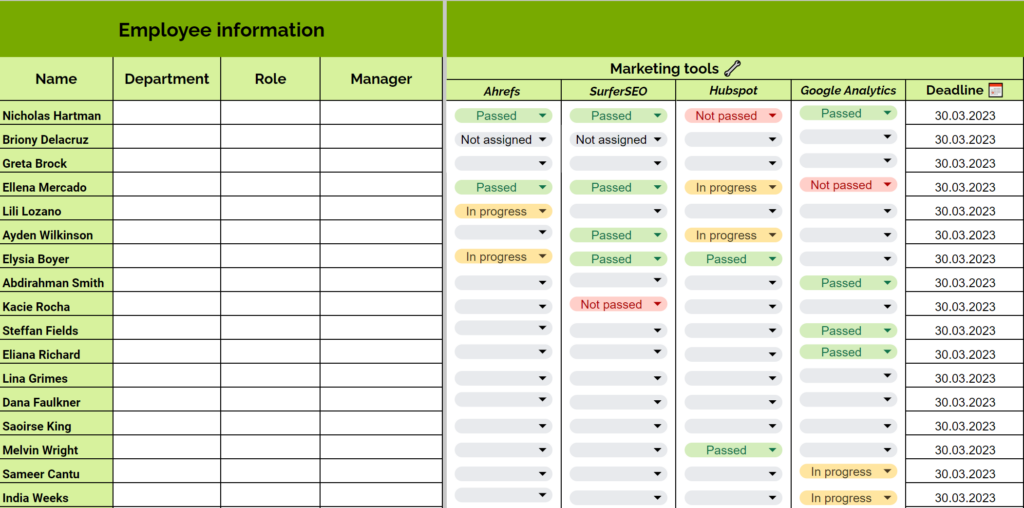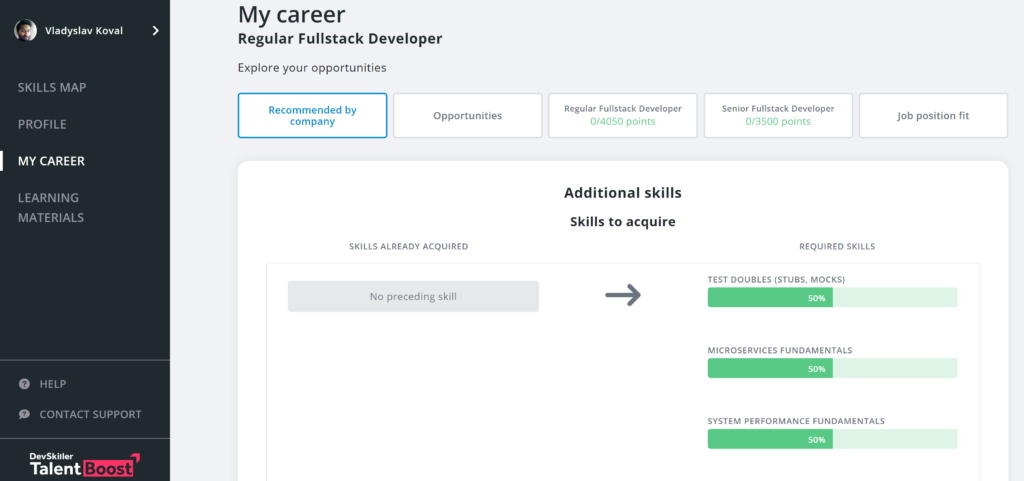What is a training matrix and why should you use it (free template included)

Looking to find out what a training matrix is and how to create one? You’re in the right place.
For every organization that emphasizes employee development, a training matrix is an indispensable part of the entire career development process. In plain words, a training matrix is a tool, usually, in the form of a spreadsheet, that managers use to keep track of the employee training processes within the company. As each organization is different, many things can go into a training matrix that would depend on your specific working environment and learning requirements.
Later in this article, we’ll explore how to create a baseline for your training matrix as well as provide a free training matrix template that you are most welcome to download.
Training matrix vs skills matrix
Before we proceed any further, it’s important to point out the difference between a training matrix and a knowledge and skill matrix. While both are vital parts of the company learning and development (L &D) processes, they serve different purposes.
A skills matrix provides an overview of the current skill sets employees possess as well as their proficiency level in them. In the L&D domain, a skills matrix is often used as a starting point for further training processes aimed at meeting the company goals.
On the other hand, as the name suggests, the purpose of a training matrix is to keep track of skill acquisition and discover and eliminate roadblocks in the process. This is the stage where the company actually bridges the gap between current and required skill levels.
Why your company needs a training matrix
There are a couple of reasons why your organization must have a training matrix.
As mentioned above, a few training matrix software is a must-have tool for companies that want to offer learning opportunities to their employees. Let’s take a look at some of the reasons why:
- It’s an efficient approach to tackling L&D goals as it:
- Provides a detailed overview. Streamlining learning activities of the entire company is no walk in the park and can only be done efficiently with the right toolset. This is where a training matrix comes in allowing you to keep tabs on multiple aspects of your L&D program in a more straightforward way.
- Helps you meet the deadlines. Having clear goals is one thing, but making sure that everything goes according to plan is another. This is why you must add deadlines for each stage of the learning process in the training matrix.
- Better employee engagement and retention rates:
- Helps boost employee retention. Did you know that 94% of employees prefer to stay at a company longer if they have development opportunities? People thrive the most when they understand what they’re required to do to advance in their career. So it’s only natural that providing a clear development path has a positive impact on employee retention.
- Improves role performance. As indicated in a survey made by Glint, a whopping 97% of employees want to increase their learning time or at least keep the current amount. The higher proficiency level of your employees are, the better they’ll perform in their role.

Source: Workplace learning report
How to create a training matrix
Now let’s look at the most crucial steps to make when creating a training matrix. Consider these as the foundation on which you can build your own custom solution.
- Identify training requirements
First and foremost, you need to narrow down the list of requirements that are aligned with the company goals. To do so, you can consult with an in-house or external expert that already has extensive experience in the field. Or you use a talent development tool for mapping out role/position requirements with pre-defined skills.
- Fill in the employee information (for example by team)
Next, create a section with employee information where you list their names, department, position, team or even project depending on your specific requirements.

A snapshot from DevSkiller training matrix template
- Add learning materials
Now that you’ve already decided on specific skills your employees need to acquire, it’s time to add learning materials. Those can vary from online training courses, to webinars and workshops.
The important thing here is to make sure that every step in the training process is accounted for in your training matrix. For easier handling, you can also divide your training materials into subtopics corresponding to specific skill sets.
- Add completion statuses
Completion statuses will give you an overview of the overall progress as well as help you identify weak points within the training program.
Here are some examples you can use:
- Not assigned. A training task hasn’t been assigned to the employee.
- Not started. A training task has been assigned but the employee hasn’t started it yet.
- In progress. A training task is in progress.
- Not passed. The employee has failed to complete a training task.
- Completed. A training task has been completed.
5. Use formulas to get better insights
One of the benefits of using spreadsheets like Excel or Google Sheets is that you can leverage formulas to handle data more easily and flexibly.
For example, you can automatically calculate the following metrics:
- Completion rate by course. Having this information will help you identify acquisition progress for a particular skill.
- Failure rate by course. Based on this indicator, you can better gauge company weaknesses.
- Completion rate by person. This shows overall progression status for each employee.
Pros and cons of using spreadsheets
One of the most common ways to create a training matrix is by using solutions like Excel or Google Sheets. While this method can be useful, we strongly recommend using spreadsheets in conjunction with a tool like DevSkiller TalentBoost. Below you will find the biggest pros and cons to using spreadsheets:
Spreadsheets are:
- Free. If you’re on a tight budget, you’ll definitely like the fact that you can use tools like Excel and Google Sheets for free.
- Pretty easy to set up. Since spreadsheets are very popular in the business world, chances are your employees already have the necessary skills to create a training matrix.
- Agile. Should you want to customize your training matrix in more detail, you can always resort to formulas or even third-party applications and plugins. Those can significantly extend default functionality.
But spreadsheets are also rather limited because:
- Hard to maintain. While spreadsheets make handling complex data much easier, it still requires a great deal of human attention and will take a considerable amount of time to maintain. Not to mention human error often comes into play.
- Not suitable for big organizations. Companies with a large number of employees will most likely find it challenging to keep and maintain training matrix data manually. An automated solution is a good companion in this case.
It’s best to use spreadsheets alongside a talent management tool like TalentBoost. For example, you can look up skill sets for the following domains:
- Organization management
- Project lifecycle management
- IT security
- Business excellence
- Cloud
- Enterprise platforms
- Digital marketing
- Project management
- Interaction design
- UX/UI
- Software development
- Software architecture
- Infrastructure
- Soft skills

A snapshot of the Talentboost skills map
TalentBoost also allows you to:
- Create custom training requirements for any role or position
- Find the right learning resources for a variety of domains
- Provide each of your employee with a planning dashboard covering all the necessary training information for their role:

DevSkiller TalentBoost
Download our free training matrix template
Here is our free skills training and matrix template to get you started. Spreadsheets are a great way to get started but for a more complete training matrix we recommend using a tool like DevSkiller TalentBoost.
Final thoughts
Since the global economy is undergoing global change, more and more businesses put workforce upskilling and reskilling at the forefront of their priorities. This is why it’s important to have robust workflows within the company and teams that can ensure seamless and efficient training processes.
One of the pivotal aspects of that is a well-thought out training matrix aligned with the company’s goals. With its help you can track and assess progress of your L&D training programs while also providing your employees with a set of clear and achievable career requirements for each role or position.
In this article we shared some basic steps that you can take to create your own training matrix today but you can also download our training completion template for free. We also invite you to check out DevSkiller TalentBoost if you need help with developing talent in your company.
Share post